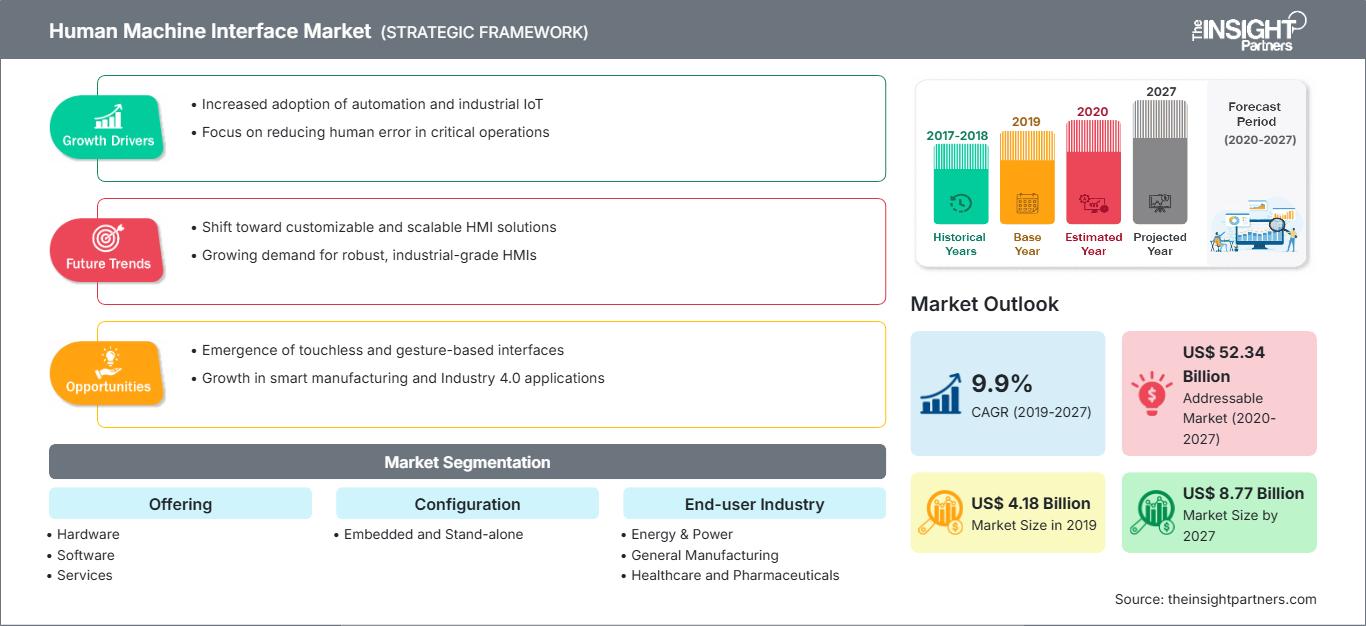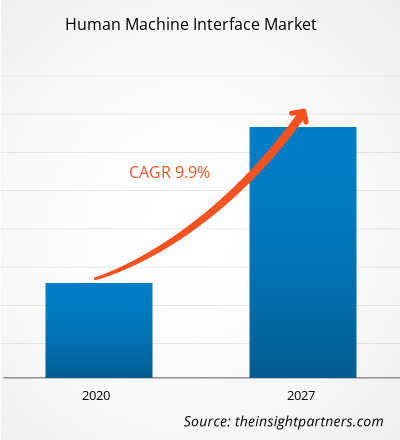Der Markt für Mensch-Maschine-Schnittstellen wurde 2019 auf 4,18 Milliarden US-Dollar geschätzt und soll bis 2027 8,77 Milliarden US-Dollar erreichen; von 2020 bis 2027 wird ein CAGR-Wachstum von 9,9 % erwartet.
Der Markt für Mensch-Maschine-Schnittstellen ist grob in fünf Hauptregionen unterteilt: Nordamerika, Europa, APAC, MEA und SAM. Europa hält den größten Anteil am Weltmarkt, gefolgt von APAC und Nordamerika. Die USA und Kanada dominieren gemeinsam den nordamerikanischen Markt für Mensch-Maschine-Schnittstellen aufgrund des wachsenden technologischen Fortschritts und der zunehmenden F&E-Aktivitäten in den Bereichen Mensch-Maschine-Schnittstellen infolge der zunehmenden Einführung von IoT und Machine-to-Machine (M2M) in verschiedenen Branchen dieser Region. Der asiatisch-pazifische Raum wird voraussichtlich aufgrund des wachsenden Fertigungssektors und der zunehmenden Nutzung moderner Technologien zur Überwachung industrieller Abläufe die höchste durchschnittliche jährliche Wachstumsrate (CAGR) auf dem Markt verzeichnen.
Eine Mensch-Maschine-Schnittstelle ist eine grafische Softwareanwendung, die Bedienern oder Benutzern Informationen zum Betriebsablauf liefert und die Interaktion zwischen Mensch und Maschine ermöglicht, sodass die Maschinen Anweisungen erhalten und die von den Bedienern angegebenen Aufgaben ausführen können. Mit anderen Worten: Eine HMI ist ein zentrales Steuerungssystem, das bei der Kommunikation von Bedienereingaben hilft und Daten und Feedback von verschiedenen SPS-Steuerungen in Echtzeit empfängt. Es bietet Einblicke in das Geschehen innerhalb des Steuerungssystems. Dadurch werden wertvolle Ausgabeinformationen für verschiedene Prozesse verfolgt, darunter Zykluszahlen, Zeiten und Rezepte. Eine HMI verbessert die Benutzerleistung und gewährleistet die Datensicherheit. Obwohl die anfänglich hohen Kosten, die mit der Bereitstellung dieser Produkte verbunden sind, eine Herausforderung für deren Produktion darstellen, sind HMIs nicht nur auf Fertigungsunternehmen beschränkt.
Passen Sie diesen Bericht Ihren Anforderungen an
Sie erhalten kostenlos Anpassungen an jedem Bericht, einschließlich Teilen dieses Berichts oder einer Analyse auf Länderebene, eines Excel-Datenpakets sowie tolle Angebote und Rabatte für Start-ups und Universitäten.
Markt für Mensch-Maschine-Schnittstellen: Strategische Einblicke

- Holen Sie sich die wichtigsten Markttrends aus diesem Bericht.Dieses KOSTENLOSE Beispiel umfasst Datenanalysen, die von Markttrends bis hin zu Schätzungen und Prognosen reichen.
Markteinblicke: Steigende Akzeptanz industrieller Automatisierungslösungen in verschiedenen Branchen
Sie erhalten kostenlos Anpassungen an jedem Bericht, einschließlich Teilen dieses Berichts oder einer Analyse auf Länderebene, eines Excel-Datenpakets sowie tolle Angebote und Rabatte für Start-ups und Universitäten.
Markt für Mensch-Maschine-Schnittstellen: Strategische Einblicke

- Holen Sie sich die wichtigsten Markttrends aus diesem Bericht.Dieses KOSTENLOSE Beispiel umfasst Datenanalysen, die von Markttrends bis hin zu Schätzungen und Prognosen reichen.
Der rasante Anstieg der Akzeptanz automatisierter Geräte, Maschinen, Steuerungen und Mensch-Maschine-Schnittstellen hat in verschiedenen Branchen deutlich an Bedeutung gewonnen. Infolgedessen kam es zu einer schnellen Akzeptanz von Produkten, Geräten und Systemen mit Mensch-Maschine-Schnittstellen, die die Kommunikation zwischen Industriemaschinen und Menschen erleichtern. Die Integration von Mensch-Maschine-Schnittstellen bietet unter anderem verbesserte Alarmsysteme, ein besseres Anlagenmanagement, Fehlerbehebung, Berichtswesen und Analysen sowie Anlagenverwaltung, was maßgeblich zur Akzeptanz verschiedener Mensch-Maschine-Schnittstellenanwendungen in verschiedenen Endverbraucherbranchen beigetragen hat. Darüber hinaus ist die Verfügbarkeit integrierter SCADA-Systeme (Supervisory Control and Data Acquisition) in der Fertigung, Energie- und Stromwirtschaft, im Bergbau, der Öl- und Gasindustrie usw. gestiegen. Auch die Gas- und andere Schwermaschinenindustrien haben den Einsatz von HMIs sowohl in Industrie- als auch in Entwicklungsländern vorangetrieben.
Auswirkungen von Covid-19 auf den Markt für Mensch-Maschine-Schnittstellen
Der Markt für Mensch-Maschine-Schnittstellen wird voraussichtlich einen deutlichen Umsatzrückgang verzeichnen. Grund dafür sind die Einstellung industrieller Aktivitäten und die daraus resultierende geringere Nachfrage nach Integrationsdiensten und dem Verkauf neuer Produkte für Mensch-Maschine-Schnittstellen. Darüber hinaus wird erwartet, dass die eingeschränkte Tätigkeit verschiedener Komponentenhersteller und Ausrüstungslieferanten in unterschiedlichen Regionen die Herstellung von HMI-Panels und anderen für die Schnittstelle wichtigen Komponenten behindert. Daher wird die Pandemie das Marktwachstum voraussichtlich zumindest in den nächsten Monaten bremsen.
Angebotsbasierte Markteinblicke
Basierend auf dem Angebot wurde der Markt für Mensch-Maschine-Schnittstellen in Hardware, Software und Dienstleistungen segmentiert. Einige Produkte für Mensch-Maschine-Schnittstellen bieten Funktionen wie Triggerauswertung, integrierte Logik, Aktionsmöglichkeiten und Event-Manager-Funktionen. Diese werden hauptsächlich zur Darstellung komplexerer Anzeigen verwendet, können aber auch als Teil der Computerlogik eingesetzt werden. Es steht eine Vielzahl von E/A-Optionen zur Verfügung, beispielsweise eine Reihe digitaler oder analoger Ein- oder Ausgänge, je nach Art der Aufgabe. Die Kommunikationsprotokolle variieren von einfachen RS-232-Verbindungen bis hin zu fortschrittlicheren Protokollen wie SERCOS, CANOpen und Ethernet-basierter Kommunikation.
Konfigurationsbasierte Markteinblicke
Einige der spannendsten Fortschritte bei Mensch-Maschine-Schnittstellen der letzten Jahre betrafen die Erleichterung des Fernzugriffs auf die Lösung. Moderne Mensch-Maschine-Schnittstellen verfügen zudem über integrierte Webserver, die die Anzeige lokaler Anzeigen auf externen Geräten mit Webbrowser wie Desktops, Smartphones oder Tablets ermöglichen. Eingebettete FTP-Server (File Transfer Protocol) ermöglichen Entwicklern die einfache Fernaktualisierung und Sicherung von HMI-Konfigurationen. Einige Mensch-Maschine-Schnittstellen können E-Mails versenden, um Benutzer über den Produktionsstatus zu informieren. Solche Fernzugriffsfunktionen können die Automatisierungsmöglichkeiten der Anlage erheblich erweitern und ein wichtiger Faktor bei der Auswahl einer HMI sein. Die eingebetteten HMIs dominierten 2019 den globalen Markt für Mensch-Maschine-Schnittstellen.
Branchenbasierte Einblicke für Endnutzer
Mensch-Maschine-Schnittstellen finden aufgrund der beträchtlich großen Anzahl industrieller Endnutzer und Prozesse ein breites Anwendungsspektrum in unterschiedlichen Branchen. Mensch-Maschine-Schnittstellen werden beispielsweise in Fertigungsanlagen, Kraftwerken, der Öl- und Gasindustrie, dem Schwermaschinenbau sowie der Elektro- und Elektronikindustrie eingesetzt. Infolgedessen wurde der globale Markt für Mensch-Maschine-Schnittstellen basierend auf den Endnutzerbranchen grob in die Branchen Energie und Strom, allgemeine Fertigung, Gesundheitswesen und Pharmazie, Automobilindustrie und Sonstige segmentiert. Das sonstige Segment umfasst die Branchen Lebensmittel und Getränke, Luft- und Raumfahrt und Verteidigung, Bergbau, Elektro- und Elektronik sowie Schifffahrt.
Die globalen Akteure auf dem Markt für Mensch-Maschine-Schnittstellen verfolgen unterschiedliche Strategien wie Produktentwicklung und -erweiterung, um ihre Präsenz weltweit auszuweiten und so die wachsende Nachfrage zu befriedigen. Sie verfolgen diese Strategie, um ihr Geschäft hauptsächlich in Nordamerika und Europa auszubauen. Die Akteure verfolgen eine Expansions- und Investitionsstrategie, um ihren Kundenstamm weltweit zu vergrößern und ihren Markennamen weltweit zu pflegen. Nachstehend sind einige der jüngsten Entwicklungen aufgeführt: 2020: Rockwell gab mit der Unterzeichnung einer Vereinbarung in den USA seine Pläne zur Übernahme des in Ohio ansässigen Unternehmens Kaly bekannt. Kalypso ist ein Softwarebereitstellungs- und Beratungsunternehmen, das auf die digitale Transformation von Unternehmen im Industriesektor spezialisiert ist und ein umfassendes Leistungsspektrum in den Bereichen Beratung, Unternehmenstechnologie, digitale Innovation und Geschäftsprozessmanagement bietet. Diese Übernahme würde Rockwell Automation somit dabei helfen, sein Produkt- und Dienstleistungsportfolio in den Bereichen Unternehmenssoftwareberatung und Informationsarchitektur zu stärken. 2020: Rockwell Automation Inc. unterzeichnete eine Vereinbarung zur Übernahme von ASEM, SpA. ASEM mit Sitz in Italien bietet ein umfassendes Sortiment an Industrie-PCs, HMI-Hardware und -Software, sicheren Gateway-Lösungen für das industrielle IoT (IIoT) sowie Fernzugriffsfunktionen an. 2018: Rockwell Automation aktualisierte seine HMI-Software FactoryTalk View. Die neuen Funktionen dieser Softwareversion 10.0 umfassen einen besseren Zugriff auf Informationen, neue Unterstützung für mobile Geräte und eine bessere softwareübergreifende Integration zur Verbesserung der Produktivität.
Mensch-Maschine-SchnittstelleRegionale Einblicke in den Markt für Mensch-Maschine-Schnittstellen
Die Analysten von The Insight Partners haben die regionalen Trends und Faktoren, die den Markt für Mensch-Maschine-Schnittstellen im Prognosezeitraum beeinflussen, ausführlich erläutert. In diesem Abschnitt werden auch die Marktsegmente und die geografische Verteilung von Mensch-Maschine-Schnittstellen in Nordamerika, Europa, dem asiatisch-pazifischen Raum, dem Nahen Osten und Afrika sowie Süd- und Mittelamerika erörtert.
Umfang des Marktberichts zur Mensch-Maschine-Schnittstelle
| Berichtsattribut | Einzelheiten |
|---|---|
| Marktgröße in 2019 | US$ 4.18 Billion |
| Marktgröße nach 2027 | US$ 8.77 Billion |
| Globale CAGR (2019 - 2027) | 9.9% |
| Historische Daten | 2017-2018 |
| Prognosezeitraum | 2020-2027 |
| Abgedeckte Segmente |
By Angebot
|
| Abgedeckte Regionen und Länder | Nordamerika
|
| Marktführer und wichtige Unternehmensprofile |
|
Dichte der Marktteilnehmer im Bereich Mensch-Maschine-Schnittstellen: Verständnis ihrer Auswirkungen auf die Geschäftsdynamik
Der Markt für Mensch-Maschine-Schnittstellen wächst rasant. Dies wird durch die steigende Nachfrage der Endnutzer aufgrund veränderter Verbraucherpräferenzen, technologischer Fortschritte und eines stärkeren Bewusstseins für die Produktvorteile vorangetrieben. Mit der steigenden Nachfrage erweitern Unternehmen ihr Angebot, entwickeln Innovationen, um den Bedürfnissen der Verbraucher gerecht zu werden, und nutzen neue Trends, was das Marktwachstum weiter ankurbelt.

- Holen Sie sich die Markt für Mensch-Maschine-Schnittstellen Übersicht der wichtigsten Akteure
- Hardware
- PC-basiert
- Panel-basiert
- Sonstige
- Software
- Vor Ort
- Cloud
- Service
Markt für Mensch-Maschine-Schnittstellen – nach Konfiguration
- Embedded
- Stand-alone
Markt für Mensch-Maschine-Schnittstellen – nach Endbenutzerbranche
- Energie & Energie
- Allgemeine Fertigung
- Gesundheitswesen und Pharma
- Automobil
- Sonstige
Markt für Mensch-Maschine-Schnittstellen – nach Geografie
- Nordamerika
- USA
- Kanada
- Mexiko
- Europa
- Frankreich
- Deutschland
- Italien
- Großbritannien
- Russland
- Übriges Europa
- Asien-Pazifik
- China
- Indien
- Südkorea
- Japan
- Australien
- Übriger Asien-Pazifik
- Südafrika
- Saudi-Arabien
- VAE
- Übriger Naher Osten und Afrika
Markt für Mensch-Maschine-Schnittstellen – Firmenprofile
- ABB Ltd.
- Advantech Co., Ltd.
- General Electric Co.
- Honeywell International, Inc.
- Kontron ST AG
- Mitsubishi Electric Corporation
- Rockwell Automation, Inc.
- Schneider Electric
- Siemens AG
- Yokogawa Electric Corporation
- Historische Analyse (2 Jahre), Basisjahr, Prognose (7 Jahre) mit CAGR
- PEST- und SWOT-Analyse
- Marktgröße Wert/Volumen – Global, Regional, Land
- Branchen- und Wettbewerbslandschaft
- Excel-Datensatz
Aktuelle Berichte
Verwandte Berichte
Erfahrungsberichte
Grund zum Kauf
- Fundierte Entscheidungsfindung
- Marktdynamik verstehen
- Wettbewerbsanalyse
- Kundeneinblicke
- Marktprognosen
- Risikominimierung
- Strategische Planung
- Investitionsbegründung
- Identifizierung neuer Märkte
- Verbesserung von Marketingstrategien
- Steigerung der Betriebseffizienz
- Anpassung an regulatorische Trends




















 Kostenlose Probe anfordern für - Markt für Mensch-Maschine-Schnittstellen
Kostenlose Probe anfordern für - Markt für Mensch-Maschine-Schnittstellen